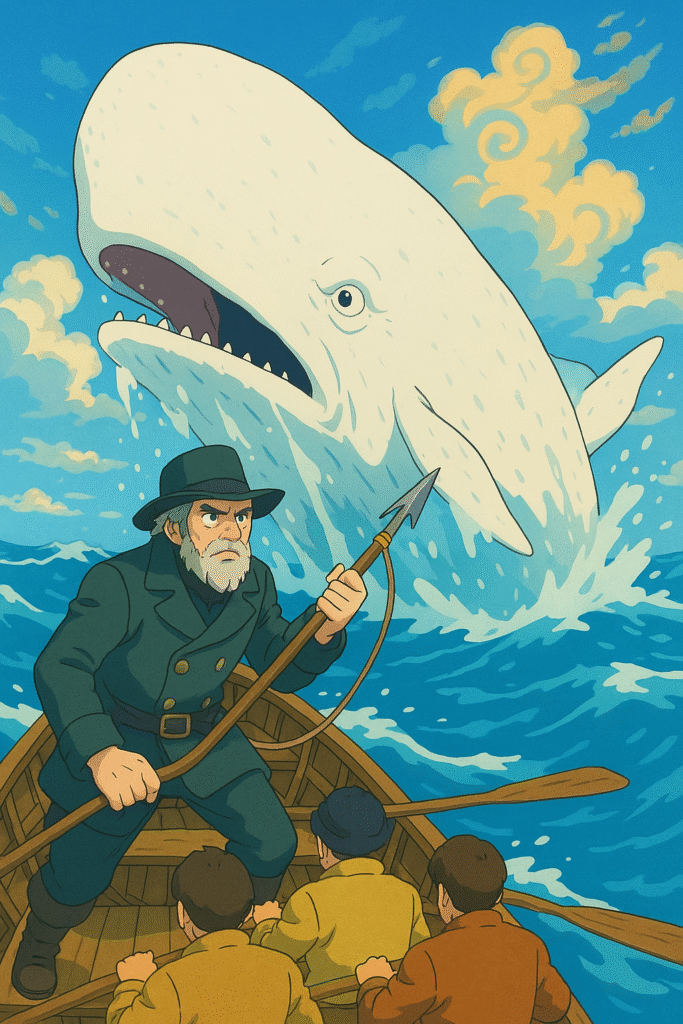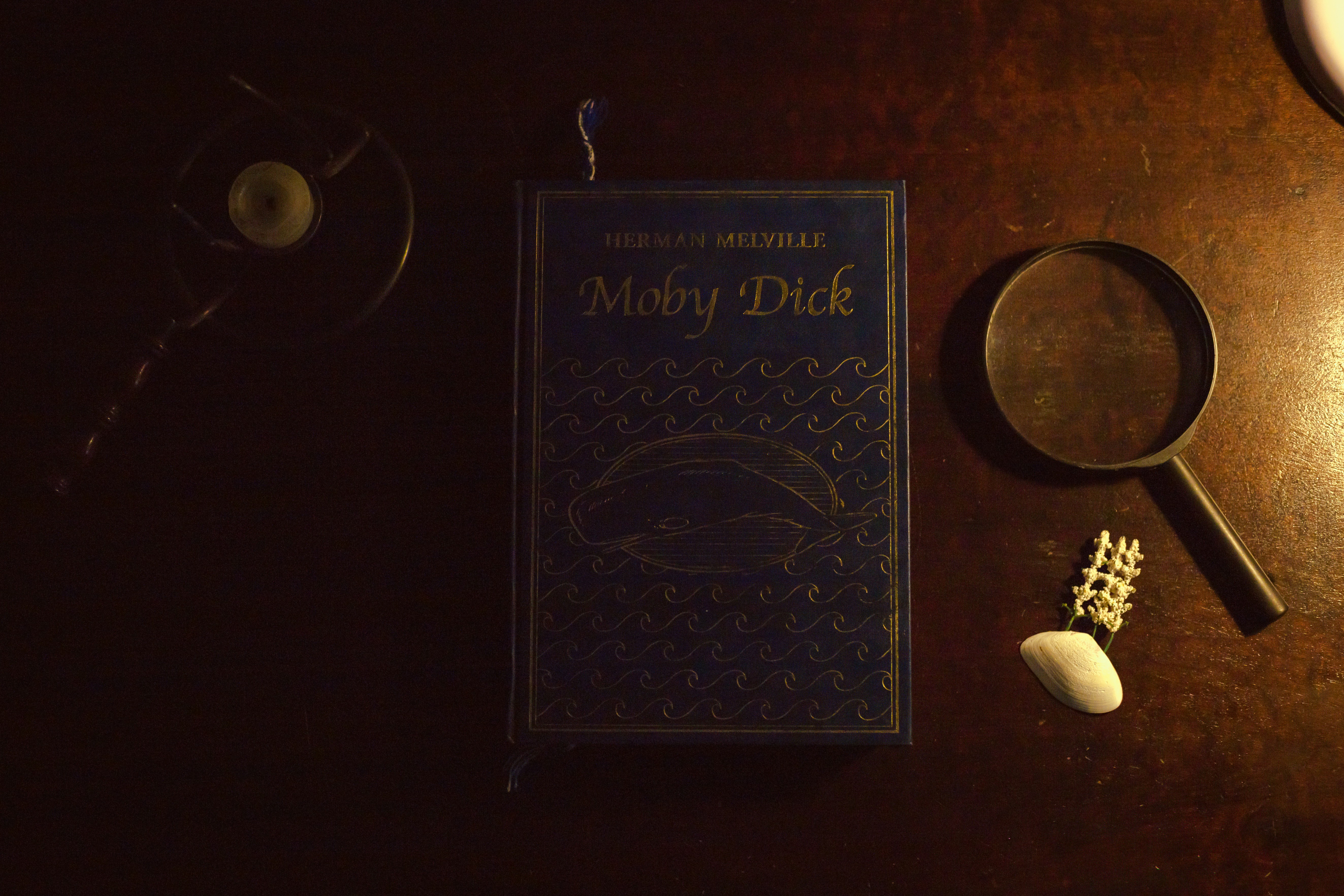By Herman Melville – A 5-Minute Summary

Moby-Dick, published in 1851, is a dense, philosophical, and adventurous novel by Herman Melville. It’s narrated by a young man who famously begins his tale with “Call me Ishmael.” The novel chronicles Ishmael’s journey on the whaling ship Pequod, under the command of the brooding, monomaniacal Captain Ahab.
Ishmael, tired of life on land, decides to sign up for a whaling voyage out of New Bedford, Massachusetts. He meets a tattooed Polynesian harpooner named Queequeg, and the two quickly form a close friendship. Together, they join the crew of the Pequod, a whaling ship led by Captain Ahab, who is initially absent when they board.
As the ship sets sail, the crew soon realizes that Ahab is not simply on a commercial whaling mission. He reveals that he’s consumed by a personal vendetta against a legendary white sperm whale named Moby Dick. During a previous voyage, the whale destroyed Ahab’s ship and severed his leg. Ahab has replaced the limb with a whalebone prosthetic and now seeks revenge, vowing to kill the creature no matter the cost.
The Pequod’s voyage becomes a global odyssey, touching on philosophical musings, encounters with other ships, and various cultural and religious reflections. The crew is made up of diverse sailors from around the world, and Ishmael reflects on the nature of humanity, the sea, and fate throughout the novel. Queequeg becomes ill and prepares for death, even commissioning a coffin, which later is repurposed as a lifeboat—one of the book’s many symbols.
Ahab becomes increasingly obsessed and reckless. His hatred of Moby Dick blinds him to danger and ethics, and he manipulates and pressures his crew to follow him. Starbuck, the first mate and a moral, God-fearing man, warns Ahab about his blasphemous obsession but is ultimately powerless to stop him.
After nearly a year at sea and several false sightings, the Pequod finally encounters Moby Dick. Over the course of three harrowing days, the crew tries to kill the whale. Moby Dick proves to be terrifyingly powerful, destroying the whaleboats and causing mayhem. On the third day, Ahab himself is killed—entangled by a harpoon line and dragged into the sea by the whale.
The Pequod is also destroyed, and the entire crew perishes—except for Ishmael. He survives by clinging to Queequeg’s coffin, which floats in the wreckage. Eventually, he is rescued by another ship, the Rachel, which had earlier been searching for its own missing crew.
The novel ends with Ishmael alone, a survivor to tell the tale of Ahab’s obsession and the destructive power of vengeance and nature.
Themes and Legacy:
Moby-Dick is far more than a simple adventure story. It dives deep into themes such as:
- Obsession – Ahab’s relentless pursuit of the whale represents how consuming revenge can lead to destruction.
- Fate vs. Free Will – The novel wrestles with the idea of predestined outcomes and human choice.
- Man vs. Nature – Moby Dick, as a natural force, represents something beyond human understanding or control.
- Existential Inquiry – Ishmael’s narrative often pauses to ponder philosophical and spiritual questions.
Though Moby-Dick was not well-received in Melville’s time, it is now considered one of the greatest American novels ever written. Its ambitious style, layered symbolism, and rich prose make it a cornerstone of literary study and a challenging yet rewarding read.

Moby-Dick 2 more minutes
‘Moby Dick,’ authored by Herman Melville, stands as a monumental work within the realm of American literature. Published in 1851, the novel has undergone various interpretations and critiques, marking its evolution from initial failure to celebrated classic. Melville’s narrative is often viewed through the prism of the American Renaissance, wherein it encapsulates the turbulence and complexity of the human experience against the backdrop of the vast and unpredictable ocean.
The story follows Ishmael, a sailor aboard the whaling ship Pequod, captained by the enigmatic and obsessive Ahab. Central to the plot is Captain Ahab’s single-minded pursuit of Moby Dick, a colossal sperm whale that had previously disfigured him. This quest serves as a multifaceted exploration of themes such as obsession, revenge, and the struggle against nature, all of which resonate deeply with existential questions about man’s place in the universe.
‘Moby Dick’ delves into profound inquiries surrounding life, morality, and the ephemeral nature of existence. Melville employs rich allegories and layered symbolism to illustrate these concepts, positioning the whale as an embodiment of the elusive and uncontrollable forces that govern human life. The novel’s complexity invites a multitude of interpretations, making it a fertile ground for scholarly analysis. Its innovative narrative style and digressive structure further add to its significance, inspiring future authors and leaving an indelible impact on the literary landscape.
